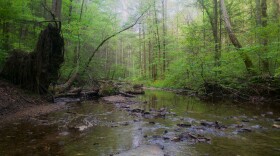As of mid-day today, Louisville Metro Public Works has used about 14,000 tons of salt on the city’s roads this winter. Most of that has been during this week’s snowstorms, and if it’s needed, there’s about 28,000 more tons of salt ready to go.
And some of that salt will eventually end up in the region’s rivers and streams.
“When salt is applied to the road, it’s going to go down a storm drain. Almost all of it,” Kentucky Waterways Alliance Director Judy Petersen said. Because Louisville’s downtown core has a combined sewer system, some of that salt will end up in a water treatment plant. But if there’s a sewer overflow, some of it will head directly into rivers and streams.
When salt gets into waterways, it increases the conductivity of the water. Conductivity is a measure of all of the dissolved solids in the water, and long-term, high conductivity can be harmful for aquatic animals.
Despite its effects on the water, cities throughout the commonwealth are probably going to keep using salt to de-ice roads, Petersen said. But there’s a way to do it better, and with minimal environmental effects.
“Obviously we’re not going to stop applying salt," Petersen said. "We need it for very important public safety reasons. The main thing, I think, is that we only apply salt when it will actually work.”
That means not applying it when it’s too cold, when it doesn’t stick to the roads, and not using too much of it. Other cities have experimented with using de-icers like urea, beet juice and byproducts from alcohol distilleries. While not necessarily a greener solution, some cities in the Northeast have also experimented with using wastewater from natural gas fracking operations—which is naturally briny—to cut down on road ice.





